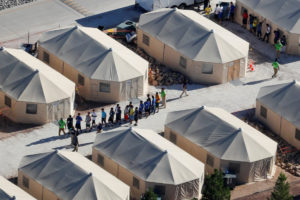Diversity among college students enrolled in Pennsylvania teacher preparation programs saw a slight increase in recent years, but more work still needs to be done to bolster the number of people of color pursuing an education career, a new report found.
In all, the number of college students of color enrolled in teacher preparation programs — college courses that prepare students to become licensed educators — jumped from 11% in 2009 to almost 16% in 2021, a report from the Penn State Center for Education Evaluation & Policy Analysis and the Pennsylvania Educator Diversity Consortium found using data from the U.S. Department of Education.
But the increase in the number of people of color pursuing a teaching degree came as the total number of students in the programs decreased, adding to the state’s ongoing teacher shortage.
“It’s kind of a good but bad or bad but good story,” said Ed Fuller, an associate professor in the Department of Education Policy Studies at Penn State’s College of Education. “Like we’ve lost a ton of people enrolled in teacher preparation programs, including aspiring teachers of color, but percentage-wise the percent of students of color in EPPs has increased over time.”
Maddie Aiken
Pitt helps launch network to support education of women and girls in Afghanistan
Here are three key takeaways from the report:
More diversity
Overall, the number of people of color enrolled in teacher preparation programs increased by nearly 5% between 2009 and 2021, meaning there are now more college students who are Black, Latinx, Asian and multiple races enrolled in the courses.
According to the report, 2016 saw the highest levels of diversity, when 17% of college students enrolled in the programs were people of color. That jump started the year prior when the percentage of students of color increased from 13.5% in 2014 to 16.2% in 2015. The lowest percentage of students of color reported was 10% in 2010.
And starting in 2019 the number of Black and Latinx students began to increase. That year, there were 685 Black students enrolled, which increased to 837 by 2021. Similarly in 2019 there were 495 Latinx students compared to 641 in 2021.
Mr. Fuller attributed the numbers to work being done to increase the amount of people of color pursuing an education career.
Locally, several initiatives are underway including the Teaching is My Favorite Color program between Avonworth, Hampton Township and South Fayette school districts, which works to give educators a safe space to voice concerns and to feel supported while bolstering the number of teachers of color entering and staying in the field. The University of Pittsburgh hosts the Genius, Joy and Love: A Focus on Black Students summer camp, a four-week program that introduces Black students and students of color to an education career.
Jocelyn Gecker
Phones are distracting students in class, so more states are pressing schools to ban them
The initiatives started as the state struggled to retain teachers of color. Between the 2016-17 and 2019-20 school years, only 5.6% of teachers were people of color compared to 33.1% of students of color, according to a previous report from Mr. Fuller. And almost 55% of Pennsylvania schools and more than one-third of school districts employed no teachers of color during the 2016-17 school year, the report found.
Those numbers continue to be felt in Allegheny County where the number of Black teachers dropped by 10% in the past decade, according to Research for Action and the Allegheny County Education Research. That means that during the 2022-23 school year, teachers of color represented 4.6% of almost 10,700 total teachers at public schools across the county. That’s compared to children of color who accounted for almost 38% of public school students.
The disparities between students and teachers of color also comes as the state grapples with an ongoing teacher shortage. Around 7.7% of Pennsylvania teachers, or a total of 9,587, left their positions between the 2021-22 and 2022-23 school years, Mr. Fuller found. And according to the Pennsylvania Department of Education, more than 15,000 in-state certifications were issued during the 2010-11 school year. By 2021-22, that number had dropped to about 4,200.
“A lot of people decide to become a teacher in elementary school,” Mr. Fuller said. “And it turns out research shows that white female students in elementary school are often told, ‘Oh, you would make a great teacher,’ ‘Teaching’s a great profession for you.’ And so that starts to get ingrained in how they see themselves at a very early age. Males and particularly students of color in K-12 rarely hear that message.”
Overall declines
Even as the number of college students of color enrolled in teacher preparation programs increased, the overall number of people completing the programs has decreased.
In 2009 there were 37,621 people, 34,544 of whom were white, in teacher preparation programs across the state, Mr. Fuller found. By 2021 that number fell to a total of 12,987 students, 10,926 of whom were white. That’s a 24,634 total decrease.
The total number of students fluctuated in that time, with the steepest decrease recorded between 2012, when there were 32,674 enrollees, and 2013, when the number dropped to 21,434. The lowest year was 2019 when there were 11,600 students.
And in 2009, Allegheny County saw a decline of 1,456 total students enrolled in teacher preparation programs, making it one of eight counties to see decreases of more than 1,000 students. Philadelphia County saw the greatest decrease of 3,141 total students, while Clarion and Delaware counties lost more than 2,000 students. Only four counties reported increases that year, including Adams, Lawrence, Lycoming and Tioga.
Solutions
Mr. Fuller in his report listed several policy changes that could help boost the number of people of color seeking a teaching degree on the state, program and district level.
For state lawmakers, Mr. Fuller suggested making teacher diversity a priority, creating regional initiatives on how to diversify the education field, supporting “Grow Your Own” teacher programs, providing training and support on cultural competence, offering financial support for recruitment programs, revising current GPA requirements and supporting educator preparation programs in efforts to recruit and support people of color.
He noted that a student teacher stipend program that passed the state budget last year has helped, but other initiatives such as scholarship programs or teacher loan forgiveness would provide more opportunities to those seeking an education degree.
At the same time, Mr. Fuller said, educator prep programs should set measurable goals about recruitment, ensure faculty are trained in culturally responsive instruction and offer financial support for students of color while districts need to make teacher diversity a priority, provide necessary training and match experienced teachers of color with new hires.
“We’ve got a long, long way to go to get back to where we were,” Mr. Fuller said. “But we’re heading in the right direction.”
First Published March 3, 2024, 5:30am




